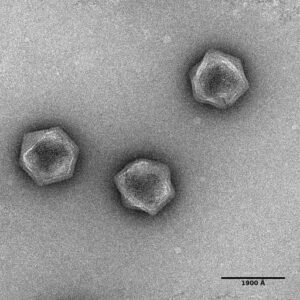Lurking in genomic shadows: How giant viruses fuel the evolution of algae
November 18, 2020
VT NEWS | NOVEMBER 18, 2020
Viruses are tiny invaders that cause a wide range of diseases, from rabies to tomato spotted wilt virus and, most recently, COVID-19 in humans. But viruses can do more than elicit sickness — and not all viruses are tiny.
Large viruses, especially those in the nucleo-cytoplasmic large DNA virus family, can integrate their genome into that of their host – dramatically changing the genetic makeup of that organism. This family of DNA viruses, otherwise known as “giant” viruses, has been known within scientific circles for quite some time, but the extent to which they affect eukaryotic organisms has been shrouded in mystery – until now.
“Viruses play a central role in the evolution of life on Earth. One way that they shape the evolution of cellular life is through a process called endogenization, where they introduce new genomic material into their hosts. When a giant virus endogenizes into the genome of a host algae, it creates an enormous amount of raw material for evolution to work with,” said Frank Aylward, an assistant professor in the Department of Biological Sciences in the Virginia Tech College of Science and an affiliate of the Global Change Center housed in the Fralin Life Sciences Institute.
Mohammad ‘Monir’ Moniruzzaman, a postdoctoral researcher in Aylward’s lab, studies endogenous viral elements, which are fragments or whole sequences of raw viral DNA that have been inserted into the infected host’s genome.
Together, Aylward and Moniruzzaman have recently discovered that endogenous viral elements that originate from giant viruses are much more common in chlorophyte green algae than previously thought.
Their findings were recently published in Nature.
Chlorophytes, a group of green algae, are an important group of photosynthetic organisms that are at the base of the food chain on many ecosystems and produce massive amounts of food and oxygen across the planet. Chlorophytes thrive in our lakes and ponds – and their dynamics with giant viruses as well as their unique evolutionary history, were central to Aylward and Moniruzzaman’s research.
Chlorophyte algae are close relatives of land plants, and studying their interactions with giant viruses may shed some light on the roles that the viruses played during the early evolution of plants.
“We now know that endogenous viral elements are common across chlorophytes, which makes you think that plants might also interact with these giant viruses. There is some data that suggests that some early plants, like moss and ferns, did experience these endogenization events over the evolutionary timeline. But we are not exactly sure about the extent of this phenomenon in other early plants,” said Moniruzzaman, the first author on this published paper.
To learn more about the prevalence of endogenous viral elements in algae, Moniruzzaman and Aylward performed a bioinformatic analysis on the sequenced genomes of different algae groups.
They discovered that 24 of the 65 genomes that were analyzed had some kinds of viral signatures in their genomes, which originated from repeated endogenization of distinct viruses. In one algal organism, Tetrabaena socialis, researchers found that around 10 percent of its genes originated from a virus in the nucleo-cytoplasmic large DNA virus family.
Although the endogenization of viruses have been well studied, studies have mostly been limited to small RNA viruses, such as the human immunodeficiency virus (HIV), the retrovirus that is responsible for causing acquired immunodeficiency syndrome (AIDS).
Aylward and Moniruzzaman’s study is one of the first to put a spotlight on large eukaryotic DNA viruses, which marks a major shift in the field.

“These large endogenous viral elements are a lot more common than previously thought. Now that we have a systematic analysis, other researchers are really going to start to pay attention. This study shows that endogenous viral elements are pretty common, and so it might possibly be a common mechanism of genome evolution. I think these results will broaden our view on the role of giant viruses as mere agents of host mortality to significant players in host genome evolution,” said Moniruzzaman.
Now that Moniruzzaman and Aylward have confirmed that endogenization is happening in larger viruses, they wonder what conditions are causing these viruses to inject EVEs into green algae in the first place – and why the hosts show no signs of rejecting them.
“We don’t know what the mechanism is or how the DNA is being maintained, but it is possible that the endogenization is a random, almost accidental process. And once the viral DNA is endogenized, it can alter the evolutionary dynamics of the host, and that it could further influence the evolution of that lineage,” said Aylward.
The idea that there is a potentially beneficial relationship at play between the host and its virus is of particular interest to Moniruzzaman.
“There might be a reason as to why the host is keeping these viral genomes within them. It’s not like these viral genes are causing the hosts to become unsuccessful or unable to survive in the environment. So that’s the thing: Are the endogenous viral elements beneficial to the host? And how are they getting in there and staying in there?” asked Moniruzzaman.
– Written by Kendall Daniels
Related Articles:






